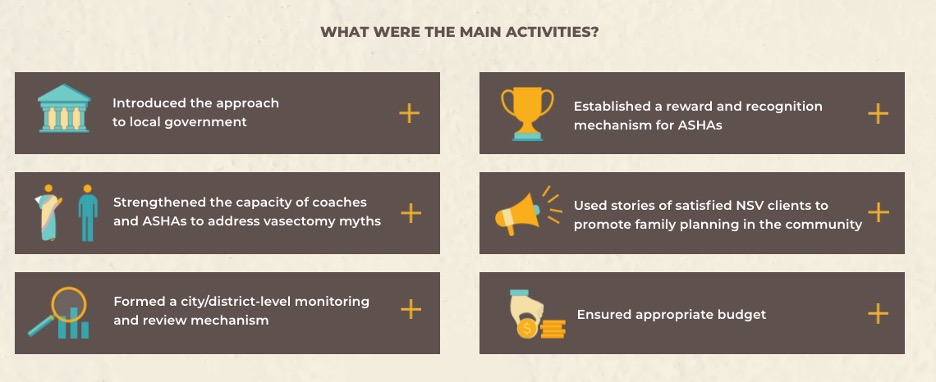The “EAST Framework” for Better Knowledge Management in FP/RH

Knowledge SUCCESS conducted behavioral science research and co-creation workshops in 2020. We learned from family planning and reproductive health (FP/RH) professionals that there are several behavioral biases that affect how they find, share, and use knowledge to inform their FP/RH programs. For example, FP/RH professionals shared that they have difficulty selecting relevant information from the vast amount of knowledge available (choice overload), as well as synthesizing and applying overly complex, non-contextualized information (cognitive overload). We unpacked these biases in our previous blog post here.
The EAST framework, developed by the Behavioural Insights Team (BIT), is a notable and well-used behavioral science framework that FP/RH programs can use to overcome these common biases in knowledge management for FP/RH professionals. EAST stands for “easy, attractive, social, and timely”—four principles that Knowledge SUCCESS as it designs and implements knowledge management activities to get the latest evidence and best practices into FP/RH programs around the world.
EAST stands for “easy, attractive, social, and timely”
Principle 1. Make It Easy
According to BIT, there are three ways to “make it easy”:
- Simplify messaging: Information should be straightforward and easy to understand. This helps address cognitive overload, as individuals will exert less mental effort to process the information (minimizing fatigue and possible confusion). Reports, videos, training, and presentations should avoid using overly technical FP/RH jargon. Remove information that does not directly support the key messages of the communications. Any recommendations should be clear, actionable, and specific in order to reduce the mental effort required to apply them. Regarding complex information that cannot be overly simplified, BIT recommends breaking this information down into simpler, more manageable “chunks.” Knowledge SUCCESS’ first edition of the What Works series used visual icons and interactive elements to present in-depth, essential elements of impactful programs in an easy-to-digest format.

- Remove hassle factors: Reducing seemingly minor costs and inconveniences, or “hassle factors,” can help spur behavior change. Logging into knowledge management platforms is a major hassle factor expressed by FP/RH professionals (and others!). As the Knowledge SUCCESS developed FP insight, a new tool for FP/RH professionals that lets them save and share important resources so they can easily return to them later, it built in the ability for users to log in via Google or Facebook so they don’t have to remember a separate password, thus alleviating hassle factors and frustrations. Online ticketing systems and communities of practice that allow members to reply back via email, rather than forcing them to log into the online system, also eliminate hassle factors for active participation.
- Use smart defaults: The EAST framework emphasizes the power of “defaults” to encourage desired behavior. In general, people tend to stick with given or pre-selected options, which explains why you are more likely to continue using your same mobile network provider instead of shopping around for a cheaper alternative. In the knowledge management realm, you can make use of this by setting the default for readers to be subscribed to an online newsletter and giving them the option to “uncheck” the box if they do not wish to subscribe.
Principle 2: Make It Attractive
You can bring a horse to water, but you can’t always make it drink. This leads us to the “make it attractive” principle: addressing inactivity after the information has been simplified, hassle factors have been removed, and defaults have been set. This principle is based on the idea that we are more likely to do something if we find it attractive or if we stand to gain a reward. Attraction can be created by several factors, such as emotional advertisements on TV or pictures throughout a book, in lieu of just text. Knowledge SUCCESS has infused this principle in a number of our publications, including What FP Programs Can Do Right Now in Response to the COVID-19 Pandemic.
Attraction can be created by several factors, such as emotional advertisements on TV or pictures throughout a book, in lieu of just text.
Rewards tend to have a strong effect on driving compliance with desired behaviors. For example, when Knowledge SUCCESS wanted to stimulate innovation for new knowledge management solutions, we launched The Pitch, a series of regional competitions among FP/RH stakeholders in sub-Saharan Africa and Asia to design and implement knowledge management innovations, with the chance for four participants to be selected for a sub-award for up to $50,000 each. Alongside monetary incentives, gamification can drive attraction, which has proven to be effective across many fields. Gamification leverages competitive spirit by creating games or activities that encourage and reward the desired behavior. On FP insight, for example, users who complete a scavenger hunt to learn how to use key features of the platform earn a visual badge on their profile, letting other users know they’re an “Explorer.”
Principle 3: Make It Social
Leveraging social norms can encourage (or discourage) certain behaviors. How our social network perceives and engages in an activity has a great influence on our individual behavior, as most people want to conform and act in accordance with their peers at least to some extent. “Make it social” is all about leveraging two types of social norms:
- Prescriptive social norms: These norms describe how people should behave. For example, “You should share information on FP insight.”
- Descriptive social norms: These norms refer to how people actually behave. For example, “Your peers are sharing information on FP insight.”

Social norms can influence behavior in a variety of situations. One classic example is a series of trials run by the energy company OPower in the U.S. It used customers’ electricity bills to compare energy consumption among regular users and their more energy-efficient neighbors. In an effort to conform to social norms, inefficient energy users reduced household energy use by 2%–4% as a result of this comparison.
Among FP/RH professionals, prescriptive and descriptive social norms can highlight good knowledge management practices to encourage such behaviors. To increase attendance at a training or webinar, FP/RH practitioners could inform potential participants that they should attend, as the knowledge can be used to improve program implementation and sustainability. Similarly, knowledge management websites could inform their users that most FP/RH professionals experience some sort of failure or setback with program design and implementation, which may encourage these professionals to share more information on what does not work, helping others avoid repeating the same mistakes.
Principle 4. Make It Timely
People are most responsive to changing their behaviors when prompted at the right time. Understanding when people are the most receptive, and then encouraging behavioral change at those exact moments, can help minimize procrastination, distractions, and forgetfulness. For example, BIT’s work around timed interventions revealed that asking people to leave a legacy gift in their wills at the moment they are writing their wills is a highly effective way of increasing charitable donations.
Understanding when people are the most receptive…can help minimize procrastination, distractions, and forgetfulness.
Likewise, promoting the use of new knowledge management management tools, systems, and practices can be targeted for specific time periods when professionals are more likely to be open to change. These time periods could be at the beginning of a new year, after a promotion cycle, or during onboarding for new recruits. Reports, blogs, or video tutorials on various FP/RH topics could be advertised online or pushed to people’s email inboxes during working hours when they are most likely already in front of their computers. This could be effective at the beginning of the day before they have begun their work. Messages at key moments (such as emails 24 hours before a webinar to help boost attendance) can also be a powerful tool for encouraging certain behaviors.
Some of the best applications of behavioral science are often the simplest. The application of the four principles of the EAST framework shows how much impact can be made with seemingly simple tweaks to the timing and framing of messaging.





